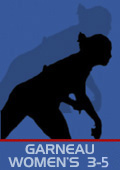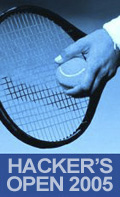| scores 2005 |
INSTRUCTION:
Hold Your Own in Doubles
Successful doubles teams have at least one thing in common—they
consistently win their service games.
By
Tom Gullikson
Excerpted
from the June 2003 issue of TENNIS Magazine
If
dropping serve in singles is bad, then doing it in doubles is sinful.
The serving team in doubles has a much bigger advantage over the returners,
which makes breaks harder to come by. So you can’t be generous by
giving them away to your opponents. Otherwise, you put no pressure on
them to hold their own serves. You won’t be a successful partnership
if you’re not holding serve on a regular basis. If you’re
having trouble doing just that, these tips should help.
The net player must be active. Too many players stand at the net and rely
on the server to win the game without helping out. You see a lot of balls
going crosscourt without the net player jumping in and making a difference.
The net player must move, and do it early in the match.
That
gets your opponents thinking a little bit. Positioning is key. I like
to see net players right in the middle of the service box so they can
move up and across to intercept a return and still get back for an overhead.
Don’t stand too close to the net-you won’t get a good angle
to cut off the return, and you’ll be susceptible to the lob.
The
server should stand no more than two or three steps away from the center
hash mark. It’s pretty standard procedure for the server to stand
in a spot halfway between the center hash mark and the doubles sideline.
This isn’t bad positioning, but you’re not fully utilizing
the angles of the court.
If
you’re a righty serving in the deuce court (or a lefty in the ad
court) and you’re positioning yourself exactly in the middle, you’ll
have a tough time hitting it down the T (unless you’ve got a good
kick serve). The returner is playing the deuce court because the forehand
is his stronger side. One of the first rules of serving is finding your
opponent’s weakness and serving to it. By serving from a wider angle,
you’re playing right into your opponent’s strength. You’re
also forcing the net player to hug the doubles alley and giving your opponent
a lot of angle to work with.
If
you’ve got a dependable second serve, don’t be afraid to let
it rip on the first. Another standard tactic is to take something off
your first serve to make sure you get a high percentage in, allowing you
to get to net more efficiently. If you’re not a great mover, it
also helps you get in better position for the first volley. And if you’ve
got a weak second serve, it’s still a smart idea. But if you have
an effective one, why not give yourself an opportunity to get a free point
or easy volley with your first serve. For example, if I were coaching
someone like Pete Sampras in doubles, I would never tell him to ease up
on his first serve, because his second serve is so good. But someone like
Venus Williams, who has a disparity of around 40 m.p.h. between her first
and second serves, should consider taking something off the first serve
to try and get it in.
When
you and your partner are at the net, don’t stand directly across
from each other. The player crosscourt from the ball should stand back
a bit, so the team is staggered. The player who’s in front of the
ball should guard against down-the-line shots. The crosscourt player is
responsible for lobs and shots hit down the middle or crosscourt. If the
players are parallel to each other and right on top of the net, it makes
the lob more difficult to cover and communication on down-the-center shots
an issue.



| Tournaments: | ||||
 EVENT SCHEDULE |
Winners of GARNEAU 3.0 - 5.0
2005 |
|||
 EVENT SCHEDULE |
Winners of GARNEAU WOMENS |
|||
 EVENT SCHEDULE |
Winners of HACKER'S OPEN 2005 |
|||
 EVENT SCHEDULE |
Winners of GARNEAU CENTANNIAL
2005 |
|||
 EVENT SCHEDULE |
Winners of GARNEAU CLUB
CHAMPIOSHIP 2005 |
|||
Archive |
2002 |
2003 |
2004 |
|